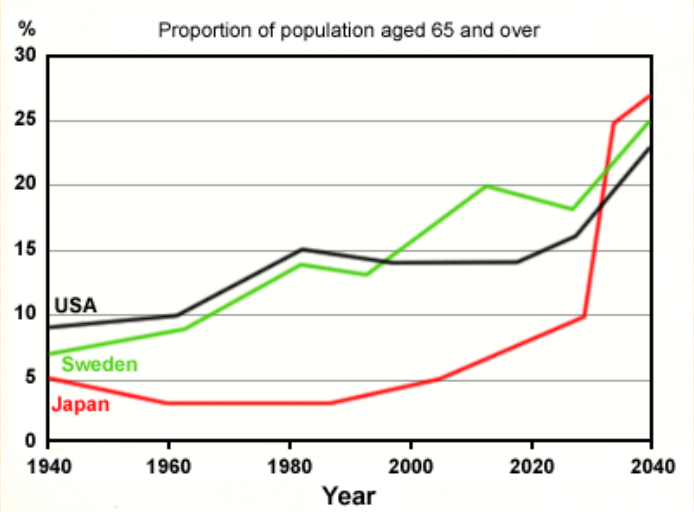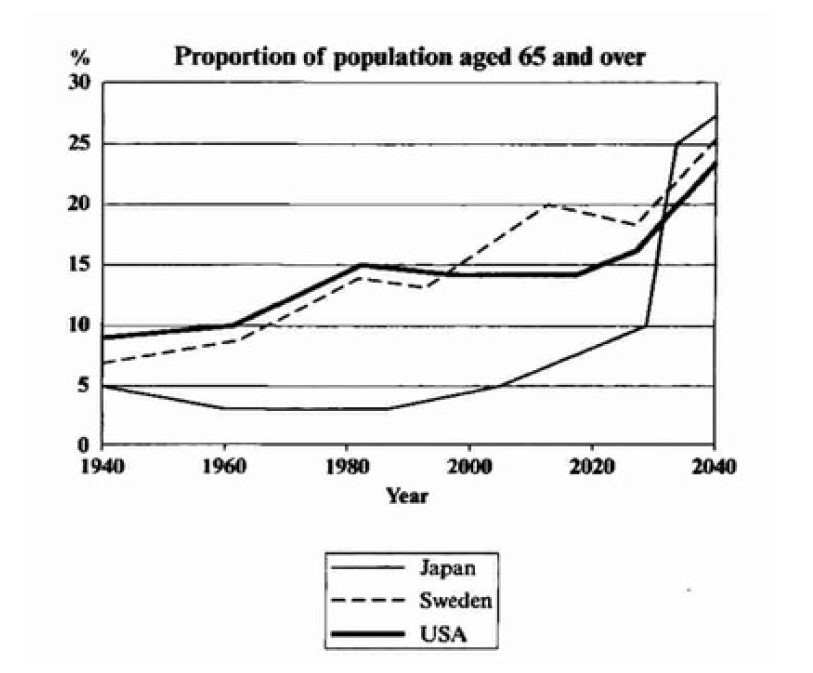
(A) Proportion of population aged 65 + . (B) Proportion of population... Download Scientific
Definition ofElderly population. The elderly population is defined as people aged 65 and over. The share of the dependent population is calculated as total elderly and youth population expressed as a ratio of the total population. The elderly dependency rate is defined as the ratio between the elderly population and the working age (15-64 years.
The graph below show the proportion of the population aged 65 and over between 1940 and 2040 in
The Australian population is ageing. The proportion of older people, those aged 65 years and over, has been steadily increasing over the last century for both men and women, and this trend is expected to continue.

Proportion of the population aged 65 or over according to principal and... Download Scientific
The 2018 ABS Survey of Disability, Ageing and Carers reported that for older Australians (aged 65 and over) with an income source, the main source of income was: government pension or allowance (57%), decreasing from 63% in 2015 superannuation, annuity or private pension (21%), increasing from 18% in 2015

Population Proportion, Sample Proportion, Population Mean and Sample Mean YouTube
Older people make up a considerable proportion of Australia's population - at 30 June 2020, over 1 in 6 people were aged 65 and over. The report details the demographic profile of older Australians, and adopts a person-centred model to report on their health and wellbeing across key domains.

Proportion of population aged 65 and over Download Scientific Diagram
World Bank staff estimates using the World Bank's total population and age/sex distributions of the United Nations Population Division's World Population Prospects: 2022 Revision. License : CC BY-4.0 Line Bar Map - Population ages 65 and above, total from The World Bank: Data

Research Highlights on Health and Aging
Proportion of population aged 65 years & over In the year ending 30 June 2019, the number of people aged 65 years and over increased by 125,400 people (or 3.2%). In the year ending 30 June 2019, the population aged 65 years and over grew in all states and territories. The largest percentage increase in this group was in the Northern.

Proportion of Population Aged 65 and Over in Major Developed Countries. Download Scientific
Overall, it is clearly shown that the proportion of the population who aged 65 or above in the USA and Sweden increases from 1940 to 2040 with slight drops in between whereas that in Japan decreases starting from 1940 to 1980 before a sharp rise in the number of elderly people in that country.

Proportion of the population aged ≥65, proportion of the population at... Download Scientific
Both the number of people at the older ages is growing and older people are representing an increasing share of the total population (CEPAR 2021). Recent data show that: At 30 June 2020, there were an estimated 4.2 million older Australians (aged 65 and over) with older people comprising 16% of the total Australian population (ABS 2020b).

IETLS writing task 1 Proportion of population ages 65 and over in the US, Sweden and Japan
At 30 June 2020, approximately 4.2 million people (16% of Australia's total population) were aged 65 and over. This report focuses on older Australians - generally those aged 65 and over, unless otherwise specified.

The graph below shows the proportion of the population aged 65 and over between 1940 and 2040 in
Overview of the characteristics of the population aged 65 years and over in 2021 including legal partnership status, living arrangements, ethnicity, religion, health, disability and caring.

Pin on Historical Maps
Between 2015 and 2050, the proportion of the world's population over 60 years will nearly double from 12% to 22%. Overview People worldwide are living longer. Today most people can expect to live into their sixties and beyond. Every country in the world is experiencing growth in both the size and the proportion of older persons in the population.

The Graph Below Shows The Proportion Ò The Population Aged 65 And Over Between 1940
The subgroups that make up the CALD population can also change over time (see 'Demographic profile' above). As with all older people, the proportion of older people (aged 65 and over) from CALD backgrounds who need assistance with core activities (communications, self-care and mobility) increased with age (Figure 2B.5).

Exercise 1 The chart shows the proportion of population aged 65 and over in three different
Population ageing is characterised by a rise in the share of the older people resulting from longer life expectancy (see indicator "Life expectancy at birth and survival rate to age 65" in Chapter 3) and declining fertility rates.

The Graph Shows The Proportion of The Population Aged 65 and Over Between 1940 and 2040 in Three
In 1980, 15% of the German population was aged 65 or over. By 2000, this figure had risen to 20%. Meanwhile, rates for the United Kingdom and Canada were roughly 14% and 10% respectively in 1980, and by 2000 both countries had risen to 15%. Projected figures for 2030 show a further 5% increase in the elderly population in Germany, reaching 25%.

Aging National Policies World Health Systems Facts
Ageing population Like most developed countries, Australia's population is ageing as a result of sustained low fertility and increasing life expectancy. This has resulted in proportionally fewer children (under 15 years of age) in the population and a larger proportion of people aged 65 and over. Graph Table Download

The Graph Below Shows the Proportion of The Population Aged 65 and Over IELTS Fever
Australia has an aging demographic. The proportion of the Australian population aged 65 and over was 15% in 2017, a trend which is expected to continue to grow. It is estimated that by 2057 older people will account for 22% of the Australian population which translates to 8.8 million people. This increase in elderly population is due to what is known as The Australian Baby Boom (years 1946 to.